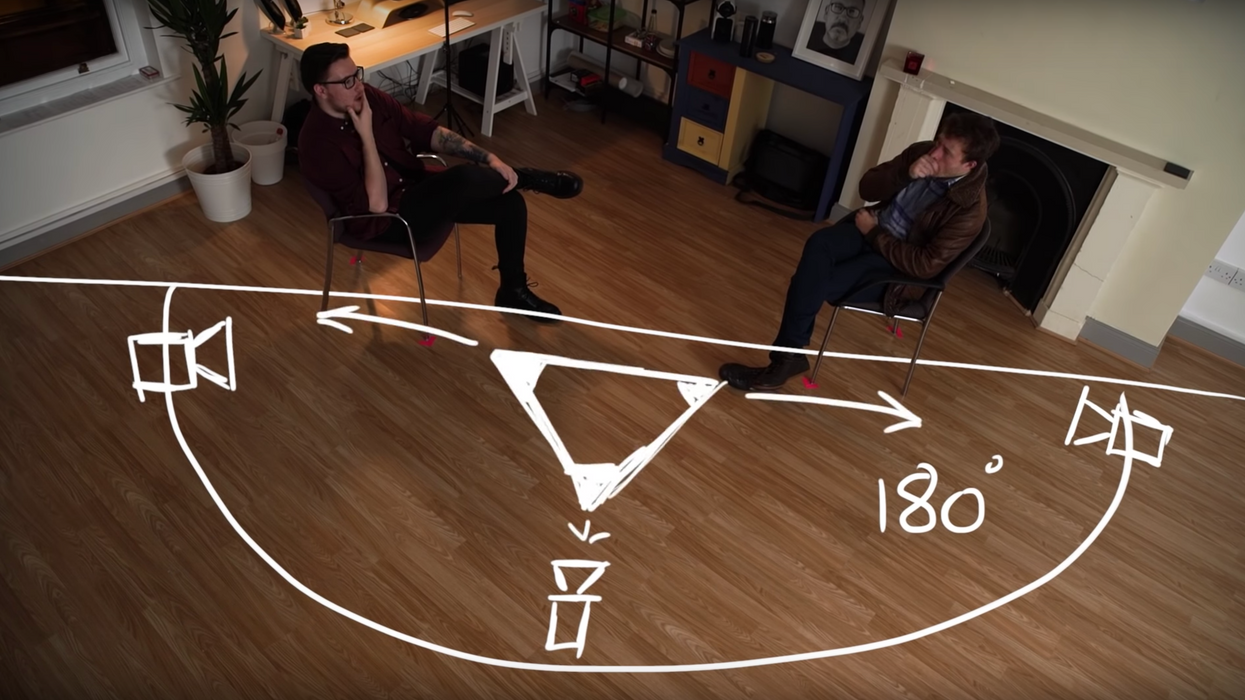Techniques That Will Keep You From Breaking the 180-Degree Rule
Unintentionally breaking the 180-Degree Rule could mean disaster for your project.

Imagine shooting one of the best scenes you've ever shot. It's gorgeous, the lighting is perfect, and performances are brilliant—you think, "I actually might be the best filmmaker in the entire friggin' world," until—until you go in to edit your masterpiece and realize that you broke the 180-Degree Rule. Choking back buckets of rage tears, you flag the problematic clips, heave a heavy sigh, and call your cast and crew to beg them for a re-shoot.
Even the best of us have had this horrible experience at least once in our careers, and that's because, in the chaos of shooting coverage, it's easy for filmmakers to lose their bearings and unintentionally jump the line. What results is footage that is more often than not unusable and a very frustrated team that is probably wondering how you managed to make such a big mistake.
In this video, the team over at The Film Look show you a few helpful tricks that will help you avoid breaking the 180-Degree Rule once and for all. Check it out below:
What is the 180-Degree Rule?
The 180-Degree Rule is one of the first concepts beginners learn in cinematography, but for some reason, it's one of the hardest to adhere to. It seems simple enough: draw an imaginary line that bisects the space between your characters, place your camera anywhere on one side of the semi-circle, and do not cross over to the other side. This, of course, establishes a spatial relationship between on-screen elements that your audience can make sense of—i.e. they can orient themselves easily because they know where everybody and everything is.
So, for example, if you're shooting a 2-shot that has Character A on the left side of the frame facing toward the right side and Character B on the right side of the frame facing toward the left side (to put it simpler, two people on either side of the frame looking at each other), you have to make sure that your close-ups and over-the-shoulder shots match the perspective of the 2-shot.
How do you avoid breaking the 180-Degree Rule?
Some filmmakers may be able to orient themselves easily on set and never risk crossing the line, but if you're like how I was when I first started, you would benefit from having something there to help you visualize the space you can shoot in. Here are a few aids you can use, including the two from The Film Look team, that will help you stay on the right side of the line.
- The String Test: Have your subjects hold a length of string between them. Then, tie another length of string to the middle of it and connect it to your camera. This will show you the area in which you can shoot without crossing the 180-degree line. If you cross the string between your characters, or if the string connected to your camera touches your characters, you are crossing the line.
- Gaff Tape Reminders: Write the names of your characters on a bit of gaff tape and draw an arrow in the direction in which they should be facing. Then, place the tape on your camera as a reminder.
- Diagram Your Shots: Another great way to avoid crossing the 180-degree line is to simply plan your shots ahead of time. Drawing up a storyboard that details the positioning of your characters and camera will help you catch any problematic setups before you're on set.
So...no breaking the 180-Degree Rule ever?
You can break the rule. You can break every rule. Just make sure that it's intentional. There are plenty of examples of this in cinema, from the red bathroom scene in The Shining to multiple scenes in Fight Club, and each example uses the rule break to communicate a variety of things to their respective audiences. In The Shining, it was a mixture of Jack's growing madness, paranoia, and complicated identity match with Grady. In Fight Club, it had a lot to do with the fact that [SPOILER ALERT] that Tyler Durden (Brad Pitt) and the Narrator (Edward Norton) were the actually same person.
Crossing the line creates confusion, mystery, and has a strange connection to multiple personalities and identity.

Check out articles from our archive if you want to learn more about the 180-Degree Rule.
Source: The Film Look














